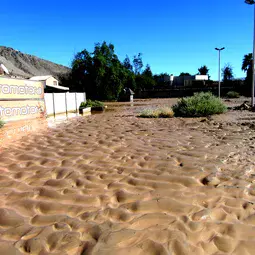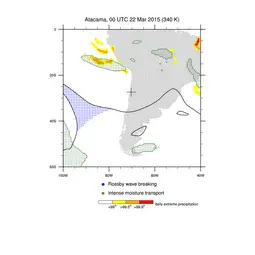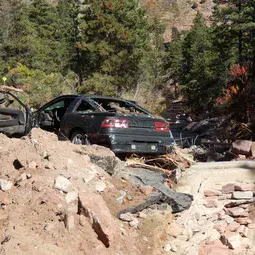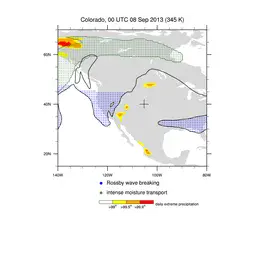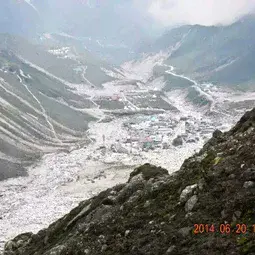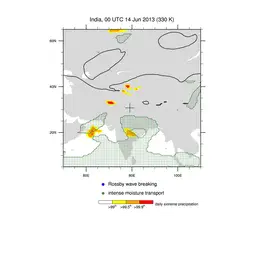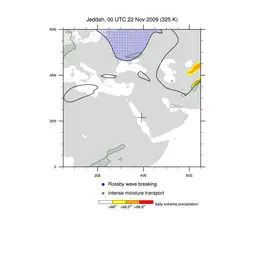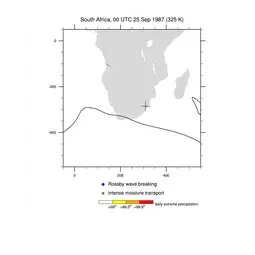Breaking waves and moisture transport drive extreme precipitation events
9 March 2021
MUNICH — Around the world each year, extreme precipitation events cause catastrophic flooding that results in tragic loss of life and costly damage to infrastructure and property. However, a variety of different weather systems can cause these extreme events, so a detailed understanding of the atmospheric processes that lead to their formation is crucial.
Now, for the first time, a global analysis reveals that two intertwined atmospheric processes drive the formation of many large-scale extreme precipitation events around the world, particularly in dry subtropical regions where they can inflict catastrophic flooding, as occurred in March 2015 in the Atacama Desert.
Previous research on extreme precipitation events has mostly focused on wet regions, where cyclones are typically responsible for these events, whereas dry subtropical regions have been less studied. However, it is precisely these dry subtropical regions, including deserts, “where these mysterious events are least expected, but can cause devastating impacts,” says Andries-Jan de Vries, an atmospheric scientist at ETH Zürich and the Max Planck Institute for Chemistry in Mainz, Germany, who authored the new study.
The results, published in the European Geosciences Union (EGU) journal Weather and Climate Dynamics, improve our understanding of atmospheric processes and weather systems that lead to extreme precipitation events. This, in turn, could help improve forecasts, perhaps leading to the development of early warning systems that could save lives.
The results could also improve our understanding of how these extreme events will respond to climate change. The intensity and frequency of these heavy rainfall events have been increasing in recent decades, and the trend is projected to continue under global warming.
Breaking Waves and Moisture Transport
This study highlights the role of two atmospheric processes in the formation of extreme precipitation events: the breaking of Rossby waves and intense moisture transport.
Rossby waves, also called planetary waves because they arise due to Earth’s rotation, are waves occurring in the ocean and atmosphere that were first discovered in the 1930s by Carl Rossby. In the atmosphere, Rossby waves determine to a large extent the weather in midlatitude regions. Due to nonlinear processes, Rossby waves can amplify and eventually break (similar to ocean waves moving onshore).
Intense moisture transport refers to large masses of water vapor moving horizontally in the atmosphere. The process has been linked to extreme precipitation and flooding, often along the western coasts of continents. When the moisture transport appears in an elongate-shaped structure reaching lengths of several thousand kilometers, it is better known as an “atmospheric river.”
“When Rossby waves amplify and break, cold-air masses intrude from high latitudes into lower latitudes, and vice versa,” De Vries says. “This atmospheric process can drive intense moisture transport, destabilize the troposphere, and force air masses to ascend, which together favor the formation of extreme precipitation.”
One key finding of the study is that the severity of the extreme precipitation is strongly influenced by the characteristics of the two atmospheric processes. “The stronger the wave breaking and the more intense the moisture transport, the larger the precipitation volumes,” De Vries says.
Extreme Precipitation and Catastrophic Flooding
De Vries analyzed daily extreme precipitation events occurring around the world between 1979 and 2018. The analysis focused on larger-scale events and did not consider very local short-duration heavy rainfall, which are typically caused by single thunderstorms.
He found that Rossby wave breaking can explain more than 90 percent of extreme precipitation events over central North America and the Mediterranean. Over coastal zones, however, more than 95 percent of the extreme precipitation events were driven by intense moisture transport, which is consistent with the findings of previous studies on atmospheric rivers.
One of the most interesting findings was the discovery of locations where the two processes combined drive the extreme events. “Importantly, the combined occurrence of these two atmospheric processes can explain up to 70 percent of extreme precipitation events in regions where one would expect them the least—the dry subtropics,” De Vries says. “Breaking waves that reach from the midlatitudes unusually far towards the equator can draw moisture from the humid tropics into the dry subtropics, which feeds the heavy rainfall.
The study further demonstrated that the combined processes played a key role in 12 historic extreme precipitation events that resulted in catastrophic flooding, thousands of fatalities and injuries, billions of dollars in damage, and sustained socioeconomic impacts lasting well beyond the flooding event. These floods included the Natal, South Africa, floods of September 1987; the Alpine floods in October 2000; the Uttarakhand, India, floods in June 2013; the Colorado floods of September 2013; and the Atacama Desert floods in March 2015.
More information
Press release text by Sara Pratt.
All EGU journal articles are open access. When reporting on this story, please mention the name of the journal, Weather and Climate Dynamics, and, if reporting online, include a link to the paper: https://wcd.copernicus.org/articles/2/129/2021/ or to the journal website: https://www.weather-climate-dynamics.net/
Contact
Terri Cook
EGU Head of Media, Communications, and Outreach
Munich, Germany
Emailmedia@egu.eu

